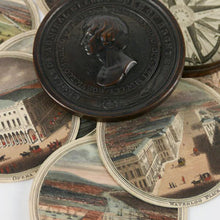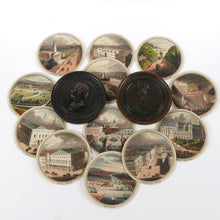Annals of the Regency, 1817
- Regular price
- £1,850
- Sale price
- £1,850
- Regular price
-
- Unit price
- /per
Adding product to your cart
Diameter overall: 8.5cm (3in)
Provenance: Norman Bobins Library
Extremely rare patriotic hand coloured aquatints illustrating the chief architectural achievements during the Regency period contained within a bronze medal case embossed with the image of Admiral Lord Nelson on the front lid and the bottom with an image of Britannia with engraved paper compass pasted in(crease to ‘Regency Park’).
Read more
Annals of the Regency which was issued to commemorate the visit to London of Duke Nicholas, future Tsar Nicholas I of Russia. Each of the views depict different architectural innovations in London, which, as the descriptive letterpress on the plate ‘Waterloo Palace’ asserts, were all sites that the future Tsar was to visit during his trip. All three of these remarkable sets were published by Edward Orme, a British engraver and publisher, who in 1815 held the role of print seller in ordinary to King George III (1760-1820); a position he would retain into the reign of King George IV (120-130). Indeed, these present works are very much in keeping with the patriotic and royal themes that much of Orme’s output tended towards and beautifully capture the splendour and power of the Regency period.
Edward Orme (1775-1848) was by turns an engraver, printseller and property developer. The son of a Manchester cloth manufacturer who came to London around 1794, his first engraving was published by his brother Daniel in that year. `in 1799 he was appointed print seller in ordinary to George III and in 1820 editor of prints in ordinary to George IV. In May 1800 he had a shop in Conduit Street, London (at the corner of George Street), and in 1801 exhibited a portrait at the Royal Academy. In the same year he established himself at 59 New Bond Street, London, at the corner of Brook Street. In a second career as a property developer, he was he helped build Orme Square in Bayswater, as well as other places in the area.








